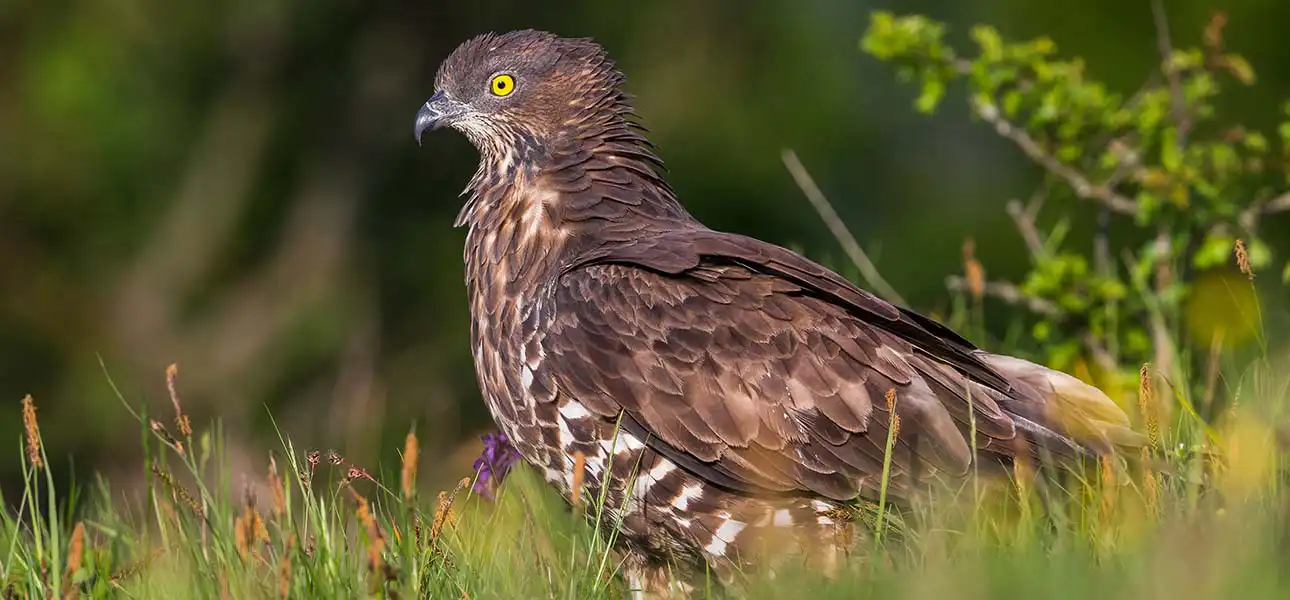
Despite its common name, Honey Buzzard is not a true Buzzard (Buteo) but is one of a small group of birds of prey that feed predominantly on grubs and adults of wasps, bees and other invertebrates. Due to their diet, they do not have overly developed beaks, whilst the beak is the typical shape of a raptor it is weak, but Honey Buzzards have tightly arranged scale-like feathers on their heads, to help prevent them from being stung.
Key Facts
Common name: Honey Buzzard
Scientific name: Pernis apivorus
Habitat: Woodland
Diet: Grubs, wasps, bees and other invertebrates
Size: Average 56cm, wingspan 142cm. Females/males (730g)
Status: Migrant breeding bird and passage visitor
Population size: 33 pairs
Conservation status: AMBER (Rare breeder in UK)
Appearance
Honey Buzzards are well-known as an identification challenge, with separation from Common Buzzard in flight being a frequent pitfall. This similarity may be more than a coincidence. It is thought that this could be a defense against potential predation by Goshawk. Although able to tackle a Common Buzzard, a Goshawk is going to be more cautious against this well-armed species, than against the much weaker Honey Buzzard. Other Honey Buzzard species in Asia have plumage similarities to certain Hawk-eagles for the same protection against local predators. Identification of Honey Buzzard is further complicated by a range of plumages, with male and female, juvenile and adult and light-phase and dark-phase variants being encountered.
Lifespan
The average age of Honey Buzzard in the wild is unknown. Adults have an 86% year-to-year survival rate. First year survival is not known, but birds have a 41% chance of reaching their second year. The oldest known wild bird was almost 12 years old (ringing recovery).
Nesting
Honey Buzzards are highly secretive birds, which are invariably associated with dense woodland. They are single brooded, and the eggs are principally incubated by the female.
Number of eggs: 2
Incubation: 30-35 days
Fledging time: 40-44 days
Habitat and Distribution
Despite their scarcity, Honey Buzzards are found across England, Scotland and Wales. They do not breed in Ireland. On migration they can potentially be seen anywhere, but they breed in dense woodland. Display flights over the trees can give the best chance to see the birds, although they can be present in an area and their presence is not known. Honey Buzzards are rare and secretive birds in the UK but are widely distributed and can be watched at several watchpoints around the country. It is a widespread species in Europe, and vast numbers can be encountered at some migration hotspots in southern Europe and the Middle East.
Movements
Highly migratory, British Honey Buzzards winter in southern Europe and Africa. Huge numbers pass through migration bottlenecks, such as Gibraltar and the Bosphorus Straits. They are often one of the last species to come through on spring migrations. Birds return to Britain in spring, with most arriving in mid-May, and leave in September/October. Scandinavian birds can migrate across the UK if weather conditions are right.
Feeding
Despite their name, Honey Buzzards do not feed on honey, but rather the grubs in nests of bees and wasps. Likewise, wasps are a far more important source of food than bees. Honey Buzzards spend a lot of time feeding on the ground and dig up wasp nests using their beaks. They seem immune to the stings of the angry adults, although if you are lucky enough to watch one, it does seem to be getting stung. There have been records, for some very lucky people, of young Honey Buzzards attacking wasp nests in gardens. On rare occasions Honey Buzzards will take other invertebrates and even small vertebrates.

